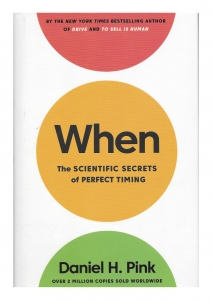Skip to content
When – Dan Pink
The one sentence summary
You can live a richer, more engaged life by paying attention to how time works.
WHAT THE BOOK SAYS 
- This is all about the scientific secrets of perfect timing. Timing is everything, but we don’t know much about it. It’s not an art, it’s a science.
- Days have certain hidden patterns that we can make use of if we understand their rhythm properly.
- The MCTQ is the Munich Chronotype Questionnaire: asking people to identify their peak behaviour on free (non-work) days – between wake, sleep, and the middle of those two times.
- This survey generates Chronotypes, which explain people who are more effective at different times of day. Larks are better in the morning, night owls at night, and third birds somewhere in the middle. Larks are more likely to be born in autumn or winter, owls more likely spring and summer.
- Vigilance breaks are important in high stakes jobs such as surgery and air traffic control. They refresh the brain and reduce likelihood of error. Restorative breaks improve performance too – at work and school.
- Pause like a pro: professionals practice a lot in the morning, take the afternoon off, then do a bit more in the evening.
- Temporal landmarks anchor most beginnings. People are more likely to run marathons when 29 and 39. Such numbers trigger people to set up a new mental account: terms, birthdays, years, etc.
- Positive mood always dips in the afternoon – that means poorer exam performance, more car crashes, and more grumpy judges declining bail. It happens all over the world.
- Once you understand that people feel increasingly happy throughout the morning, less so in the afternoon, and rising again in the evening, you can plan your day better and allow for the performance of others.
WHAT’S GOOD ABOUT IT
- High performers work for 52 minutes and take a break for 17 minutes.
- The uh-oh effect is when you reach the midpoint and realise you are running out of time. In this respect, midpoints are vital inflection points in all projects. Activity always increases as a result.
- The James Dean Effect describes a preference for a short life ending on a high rather than a long one ending on a low. This is counterintuitive. The peak-end rule refers to attributing greatest weight to the peak of an event, and the end. That’s pretty much all we remember.
- The most important meal of the day is…lunch. To pep you up before you hit the slump.
- Naps of 20 minutes or less don’t produce sleep inertia. These are optimum for power naps.
WHAT YOU HAVE TO WATCH
- There is a somewhat bizarre recommendation to drink coffee before taking a twenty-minute nap during the day – a so-called This does not address what to do if you (a) don’t drink coffee or (b) can’t nap to order.
admin2020-09-23T12:03:06+00:00
Share This Post, Choose Your Platform!
Page load link

